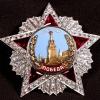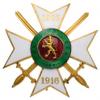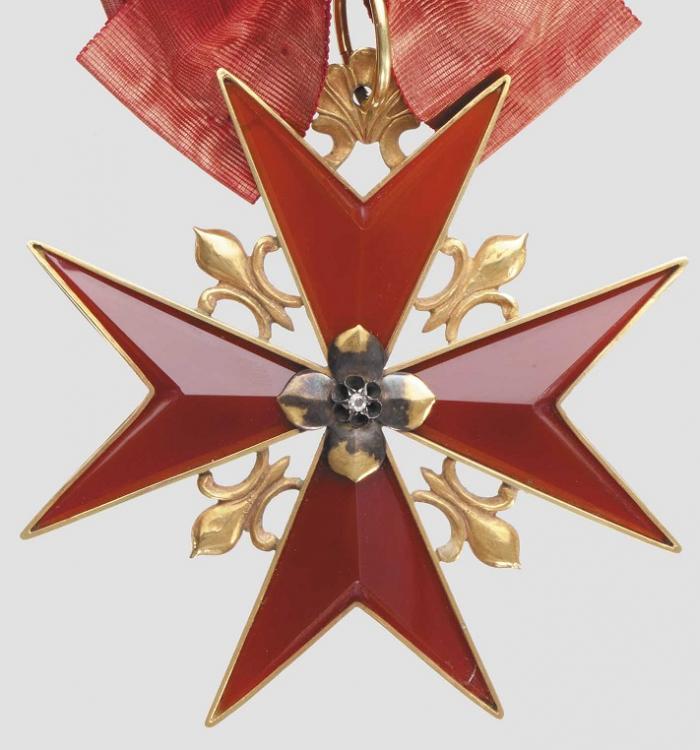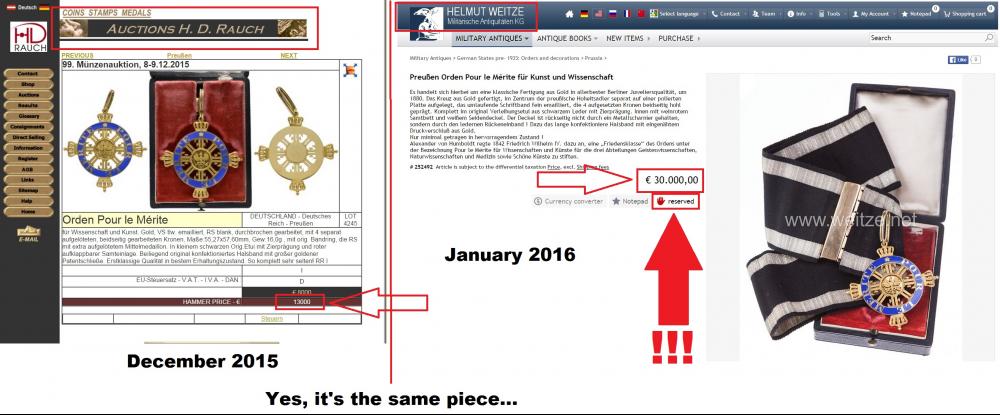-
Posts
465 -
Joined
-
Last visited
Profile Information
-
Gender
Male
-
Location
Germany
-
Interests
Europe: German states, Republic of Weimar, Third Reich, GDR, Fascist Italy, KuK, Poland, Finland, Estonia, Latvia, Lithuania, Czech, Slovakia, Czechoslovakia, Yugoslavia, Serbia, Albania, Hungary, Bulgaria, Romania, Russia, Soviet Union
Asia: Japan, Mongolia, China, Thailand, Soviet successor states in Central Asia
Special Interests: Ukraine, Ukrainian Cossacks, Cossacks in WW2, 1. Galician-SS, ROA
Recent Profile Visitors
3,451 profile views
utopis's Achievements
-

Gold Romanian Order of CRown cmdr perhaps?
utopis replied to eurorders's topic in Southern European & Balkan States
No, it's silver gilt. 750 silver wasn't uncommon in Romania at that time. The crown is the silver hallmark. Letter below the crown indicates city of manufacture, number of notches the actual composition. It's also too light to be gold. I don't have the weight for the commander's cross, but the grand cross weighs approx 36gr, bit over an ounce and is +1cm in diameter. Gold should be nearly twice as heavy. -
The above picture of the award ceremony for the Decoration for Services to the Republic of Austria is very interesting. Clearly the sash has already been tailored to the archbishop before being handed to him. So it would seem that this is indeed official practice. I always assumed that this form of wear is based on the liturgical stole which would explain why it is usually encountered on catholic clergymen or those belonging to the eastern denominations.
-

Mongolia ORDER OF THE RED BANNER OF MILITARY VALOUR
utopis replied to Vatjan's topic in People's Republic Mongolia
Like I said, these are fairly well made fakes. Still there are some inconsistencies which give them away. Don't worry about the fakers, I'm sure they reap a handsome profit margin by selling them. I recommend you study textbook authentic pieces and compare them closely. Feel free to dm me if you need any additional pointers. -

Mongolia ORDER OF THE RED BANNER OF MILITARY VALOUR
utopis replied to Vatjan's topic in People's Republic Mongolia
These are also fake. -

Mongolia Order of Military Valour & Order of the Red Combat Banner
utopis replied to Vatjan's topic in People's Republic Mongolia
The order shown in post #7 is a fake. Seemingly originating from Eastern Europe, these relatively well made pieces appeared fairly recently on the market together with a number of other rare awards (Sukhe, Red Banner for Military Valour, Civil/Industrial Valour). -
Considering that this award was only awarded 2 times, one of them to Mannerheim himself, I doubt there even are any in private collections. About two year ago a Swedish auction house offered a cased near mint 2nd class for sale. The asking price was about €30,000 however I don't recall what the result was.
-

Bulgaria Bulgarian Order of St Alexander -Two Variatians?
utopis replied to Graf's topic in Central & Eastern European States
Both the star in #66 and the set in #76 are Rothe pieces. However, the question to be answered is when these pieces were manufactured. The first star is lacking any marks and the second doesn't bear the typical "C.F.Rothe" "Wien" hallmarks. The star's overall quality also seems a little lower than what one would expect from Rothe pieces. An expert on Austrian decorations should be easily able to tell whether these pieces were made pre or post 1945. -

King Ferdinand I's decorations
utopis replied to ilieff's topic in Central & Eastern European States
Great Images, are the whereabouts of the king's bejeweled insignia known? In addition, if this is not the king's insignia, whose is it then? Where such badges awarded to high Bulgarian/ foreign nobility or are these simply later manufactured pieces for the royal family? Obviously a variation of the Maltese order comes to mind, I suggested the Tuscan decoration, mainly, because of the central stone which I only recall on this decoration and not on any other. In addition there where a few special made pieces with a white surface. However, as said before the Tuscan breast star had a different design than the badge. -

King Ferdinand I's decorations
utopis replied to ilieff's topic in Central & Eastern European States
Besides the Bulgarian decorations (and the Golden Fleece) only Italian decorations can be seen in the photo. In it's design the star reminds me very much of the Tuscan Order of Saint Stephen's badge, although it's breast stars had a slightly different appearance. The cross, the fleur de lis and the stone in the center are identical, however. -

King Ferdinand I's decorations
utopis replied to ilieff's topic in Central & Eastern European States
This is a very interesting photo. Not only does it show the previously unseen (?) bejeweled breast star of the St. Cyril and Methodius Order but it also serves as photographic evidence for the sash/collar badge currently on sale. Having never seen period pictures depicting such a badge in wear but instead only rather recent pictures of similar badges worn by the royal family, I had my doubts. -
Well, let's take a closer look at it, shall we: The selling price was 13K, Rauch's fee + vat is 18.3 %, So Weitze paid roughly €15,400 (not counting shipping). I don't know how much Weitze makes a year, but making an educated guess here, I would say that when you count in all the costs (staff, business premises, tax subtractions for all the money spent on future merchandise) and subtract it from his revenue, his total tax rate is probably not that high I'd say something in the mid 30% range. Meaning that he made a profit of roughly 8K. Now keep in mind that the turnaround for that was under a month and the actual time spent on one little item not that much. That is a yield of 53%, 636% extrapolated on the year. But you see, it's not. 30 items require much more work: buying, photographing, creating the description, putting it online, storing it, communicating with the buyer, shipping. This results in a much higher transaction cost because the cost needs to be multiplied by 30! But wait that's not all: seeing as it is not very likely that he will sell all 30 items in one month, 2-6 month is more likely (based on his large client base, though that might even be a little too optimistic), that means that the monetary value of these items is not freely available, i.e. cannot be reinvested until the items are sold. Basically, you are losing money for every month these items lie around unsold, the amount of which is at the very least equal to your average yield on the common ETF, [i.e. between 1.3 and 4% (for 2-6 month respectively - based on an 8% ann. avg., not counting taxes)]. So all in all there's a huge difference whether you sell the same amount as one or as thirty items. In my opinion it comes all down to this: Of course sellers have to set a markup, otherwise they won't make a living, but usually you don't see it done so blatantly; Rauch is the second largest auction house for ODM in Austria, Weitze is the largest seller of ODM in Germany, to see the same item in such a short time frame with a price increase of 100% in such prominent places... Also, and I think this is key here: Weitze didn't provide any service at all. Sure it takes a lot of time and work to create a business like Weitze's - building a huge customer base and reputation. So if collectors, relatives of deceased collectors or relatives of the awardees turn to him to sell something, it's due to his merit (then there is the whole work on the transaction itself). But this is not the case here. The item was already on sale to the public. No one except Weitze really profited from this: not the original seller (the feeling "what he could've gotten" for this), certainly not the buyer (he'll probably never get his money back on this thing) or the potential buyers who where outbid by Weitze at the auction. It's not that due to Weitze's work an item was offered to the collector's market that otherwise wouldn't have been available to the public. Now, don't get me wrong, I fully support it from a pure free-market point of view, that's how the economy works, it's the same as the car dealer of your choice. But just look at the art market to see what happens if this gets out of hand: Paintings that go for millions, are (very often) not bought by collectors but rather by investors (sometimes even worse: money launderers). Meaning that most private collectors who actually appreciate these paintings will have no chance of acquiring them, instead they'll lie around in a vault or will decorate a mansion's living room, at best.
-
Künker is not just a regular seller of orders and medals, it is among the top four (by number of sales and customers) auction houses on this topic in Germany. The other three being Zeige, Thies and Hermann Historica. Künker is regularly selling fakes, not only Russian ones though these seem to be the most prominent. To be honest, I don't believe that they don't know what they are selling - from what I've seen they have considerable knowledge on the topic of orders and medals... but ... ya know, they get 40% of every sold item. Zeige is also selling quite a lot of fakes on a regular basis, last three auction had a few and these are just the ones I remember. The upcoming sale has some, also. Hermann Historica is also known for selling a lot of fakes. Just look at their next sale: fake/fantasy anti partisan badge in diamonds for €50K... Of all these I believe Thies to be the most honest and offering the highest quality items, at least when it comes to German stuff. The only downside is that he is mostly focused on German items.







